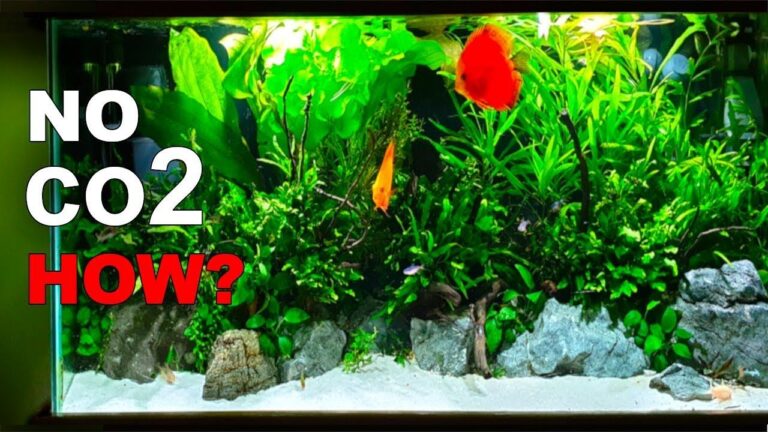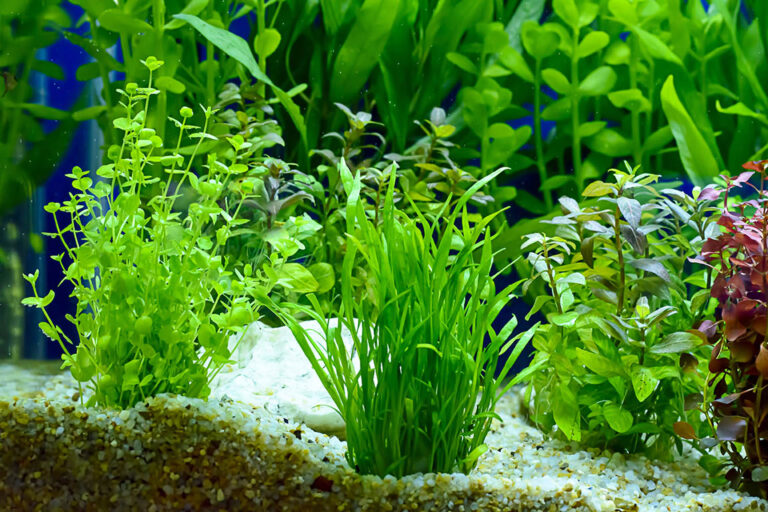How to Take Care of Aquarium Plants: Expert Tips & Tricks
To take care of aquarium plants, provide proper lighting and maintain appropriate water conditions. Regularly trim and fertilize the plants.
Aquarium plants enhance the aesthetic appeal and contribute to a healthy aquatic environment. Proper lighting is crucial for photosynthesis, helping plants grow and thrive. Choose the right type of light based on your plant species. Maintain suitable water conditions by regularly testing pH, hardness, and temperature.
Use fertilizers to supply essential nutrients like iron and potassium. Regular trimming prevents overgrowth and ensures healthy plant development. Removing dead leaves also helps in maintaining water quality. With consistent care, your aquarium plants will flourish, creating a vibrant and balanced ecosystem for your fish.
Choosing The Right Plants
Choosing the right plants is crucial for a thriving aquarium. The right plants can help maintain water quality and create a beautiful underwater landscape. This section will guide you through beginner-friendly options and advanced plant varieties.
Beginner-friendly Options
For those new to aquarium plants, start with easy-to-care-for species. These plants require minimal maintenance and adapt well to various environments.
- Anubias
- Java Fern
- Amazon Sword
Anubias are hardy plants that grow well in low light. Attach them to rocks or driftwood.
Java Ferns thrive in low to moderate light. They can be tied to decorations.
Amazon Swords are robust and can grow in various conditions. They need nutrient-rich substrate.
Advanced Plant Varieties
For experienced aquarists, consider more challenging plants. These varieties often require specific conditions and care.
- Glossostigma Elatinoides
- Rotala Rotundifolia
- Hemianthus Callitrichoides
This plant needs high light and CO2 injection. It creates a carpet effect.
Rotala needs high light and frequent trimming. It adds vibrant colors to the tank.
Also known as Dwarf Baby Tears, this plant requires high light and CO2. It forms a lush carpet.

Credit: www.youtube.com
Setting Up The Aquarium
Creating a perfect environment for aquarium plants starts with proper setup. This ensures healthy plant growth and a vibrant tank.
Tank Size And Type
The first step is choosing the right tank size and type. Small tanks are great for beginners, but large tanks provide stability. Glass tanks are popular for their clarity, while acrylic tanks are lightweight and durable.
- Small tanks (5-20 gallons) – Easier to manage but less stable.
- Medium tanks (20-40 gallons) – Good balance for most plants.
- Large tanks (40+ gallons) – Ideal for advanced setups and stability.
Substrate Choices
Choosing the right substrate is crucial for plant health. Substrates provide nutrients and anchor plant roots. Here are some popular options:
| Substrate Type | Benefits |
|---|---|
| Gravel | Good for anchoring roots, but lacks nutrients. |
| Sand | Fine texture, suitable for delicate roots, limited nutrients. |
| Plant-specific substrates | Rich in nutrients, promotes healthy plant growth. |
Gravel is a common choice but lacks nutrients. Sand works for delicate roots but offers limited nutrients. Plant-specific substrates are the best, providing essential nutrients for growth.
Consider using a layered substrate. Place nutrient-rich soil at the bottom and cover it with gravel or sand. This combination supports plant health and keeps the tank clean.
Water Quality Essentials
Ensuring good water quality is crucial for healthy aquarium plants. Clean, balanced water supports vibrant plant growth. Monitoring water parameters helps maintain this balance. Let’s dive into the essentials of water quality for aquarium plants.
Ph Levels
The pH level measures the acidity or alkalinity of water. Most aquarium plants thrive in a pH range of 6.5 to 7.5. Use a pH test kit to check your water regularly.
- Adjusting pH: If the pH is too high, add driftwood or peat moss. These naturally lower pH.
- pH Too Low: Use crushed coral or limestone. These raise the pH.
Consistent pH levels keep your plants healthy. Avoid sudden changes in pH. Sudden changes can stress your plants.
Water Hardness
Water hardness refers to the amount of dissolved minerals in the water. It includes calcium and magnesium. Aquarium plants usually prefer soft to moderately hard water.
| Water Type | Hardness (dGH) |
|---|---|
| Soft | 0-6 dGH |
| Moderately Hard | 6-12 dGH |
| Hard | 12-18 dGH |
Testing Hardness: Use a water hardness test kit. This helps you know the hardness level.
- Softening Water: If water is too hard, use reverse osmosis (RO) water.
- Hardening Water: If water is too soft, add minerals with aquarium products.
Maintaining the right water hardness ensures strong, healthy plants. Regular checks and adjustments keep the balance perfect.

Credit: pethelpful.com
Lighting Requirements
Proper lighting is crucial for the health of your aquarium plants. It supports photosynthesis and helps plants thrive. Understanding the right lighting requirements is essential. This includes light intensity, duration, and timing.
Light Intensity
Light intensity affects plant growth. Some plants need high light, others low. Use a light meter to measure intensity. Adjust lights based on plant needs. High-light plants need 30-50 lumens per liter. Low-light plants do well with 10-20 lumens per liter. Choose the right bulbs to match plant requirements.
Duration And Timing
Plants need a balanced light duration. Too much light causes algae. Too little light stunts growth. Aim for 8-10 hours of light daily. Use a timer to automate this. Consistent timing is key for plant health.
Here is a simple table showing light duration recommendations:
| Plant Type | Light Duration (Hours) |
|---|---|
| Low-Light Plants | 6-8 |
| Medium-Light Plants | 8-10 |
| High-Light Plants | 10-12 |
Monitor your plant’s response. Adjust duration if needed. Healthy plants show vibrant colors and steady growth.
Nutrient Management
Proper nutrient management is crucial for healthy aquarium plants. Plants need various nutrients to grow strong and vibrant. Failing to provide these can lead to poor plant health. Below, we will discuss the importance of fertilizers and CO2 injection in managing nutrients for your aquarium plants.
Fertilizers
Fertilizers are essential for aquarium plants. They supply necessary nutrients like nitrogen, phosphorus, and potassium. These nutrients are often lacking in aquarium water.
- Macro-nutrients: These include nitrogen, phosphorus, and potassium. Plants need them in large amounts.
- Micro-nutrients: These include iron, manganese, and zinc. Plants need them in small amounts.
Use a good quality liquid fertilizer. Add it to your aquarium weekly. This ensures your plants get the nutrients they need.
Co2 Injection
CO2 injection is another important aspect of nutrient management. CO2 helps plants grow faster and healthier. Aquarium water often lacks enough CO2 for plants.
Here are the steps for setting up a CO2 injection system:
- Choose a CO2 system: There are pressurized and DIY systems available.
- Set up the system: Follow the manufacturer’s instructions carefully.
- Monitor CO2 levels: Use a CO2 drop checker to ensure optimal levels.
Maintaining proper CO2 levels helps plants absorb other nutrients better. This results in lush, green plants.
By properly managing nutrients, you can enjoy a thriving, beautiful aquarium. Happy planting!
Pruning And Maintenance
Proper pruning and maintenance are essential for healthy aquarium plants. Regular trimming helps plants grow better. It also keeps the tank looking neat. Algae control is also a part of this process.
Trimming Techniques
Trimming plants in an aquarium is easy. Use sharp scissors for a clean cut. This helps the plant heal quickly. Always trim above a node or leaf. This encourages new growth.
- Trim fast-growing plants every week.
- Slow-growing plants need trimming once a month.
- Remove any dead or yellow leaves.
Always be gentle while trimming. Avoid pulling or tearing the plants. This can damage them.
Algae Control
Algae can overgrow and harm your plants. Keeping algae in check is important. There are several ways to control algae.
- Reduce the light duration to 8 hours a day.
- Do not overfeed the fish.
- Introduce algae-eating fish or snails.
| Method | Description |
|---|---|
| Light Control | Reduce light to prevent algae growth. |
| Proper Feeding | Avoid overfeeding to reduce excess nutrients. |
| Algae Eaters | Add fish or snails that eat algae. |
Regular water changes also help in algae control. Clean the tank glass with an algae scraper. Always monitor algae levels in your tank.
Dealing With Plant Diseases
Taking care of aquarium plants can be challenging. Plant diseases can be a big problem. To keep plants healthy, you must know how to deal with diseases.
Common Issues
Aquarium plants face many issues. Algae can cover leaves and block light. Yellowing leaves can mean a nutrient deficiency. Holes in leaves might be caused by pests. Rotting roots can be due to poor water quality. Each issue needs a different solution.
Preventive Measures
Preventing diseases is easier than curing them. Follow these tips:
- Use clean water for your tank.
- Maintain proper light levels.
- Add nutrients to the water.
- Remove dead leaves promptly.
- Check plants for pests regularly.
A table can help you remember what to do:
| Problem | Prevention |
|---|---|
| Algae | Keep light levels balanced |
| Yellowing Leaves | Add nutrients |
| Holes in Leaves | Check for pests |
| Rotting Roots | Use clean water |
Following these steps will help keep your aquarium plants healthy. This will make your tank look beautiful.
Creating A Balanced Ecosystem
Maintaining a balanced ecosystem is crucial for healthy aquarium plants. Your plants need a stable environment to thrive. This includes the right mix of fish, invertebrates, and plants. Let’s look at how to achieve this balance.
Fish And Plant Compatibility
Choose fish that are compatible with your aquarium plants. Some fish nibble on plants, while others leave them alone. Here’s a list of fish that are plant-friendly:
- Tetras – Small and peaceful, they coexist well with plants.
- Guppies – Known for their vibrant colors and gentle nature.
- Otocinclus – These fish help clean algae off plants.
- Corydoras – Bottom dwellers that do not disturb plants.
Avoid fish species that uproot or eat plants. Some of these include:
- Goldfish – They can uproot plants while foraging.
- Cichlids – Known to dig and rearrange the substrate.
- Plecos – Large plecos may damage delicate plants.
Beneficial Invertebrates
Invertebrates play a key role in maintaining a balanced ecosystem. They help keep the tank clean and support plant health. Consider adding these beneficial invertebrates:
- Snails – Such as Nerite and Malaysian Trumpet snails, they eat algae and detritus.
- Shrimp – Amano and Cherry shrimp are great for algae control and plant cleaning.
Remember to avoid invertebrates that may harm your plants. For example, some species of crabs and larger snails can be destructive. Always research before adding new species to your tank.
| Type | Species | Compatibility with Plants |
|---|---|---|
| Fish | Tetras | High |
| Fish | Guppies | High |
| Invertebrates | Nerite Snails | High |
| Invertebrates | Amano Shrimp | High |
:strip_icc()/cleaning-aquarium-plants-1381082_Final-5bc0f558c9e77c0051b23823.png)
Credit: www.thesprucepets.com
Frequently Asked Questions
How Do I Clean Aquarium Plants?
To clean aquarium plants, gently rinse them under lukewarm water. Use a soft brush to remove debris. Avoid using soap or chemicals.
What Type Of Light Do Aquarium Plants Need?
Aquarium plants need full-spectrum light that mimics natural sunlight. Aim for 8-10 hours of light daily.
How Often Should I Fertilize Aquarium Plants?
Fertilize aquarium plants weekly with liquid or root tab fertilizers. Follow the product’s dosage instructions carefully.
Can I Use Tap Water For Aquarium Plants?
Tap water is usually safe for aquarium plants. However, treat it with a water conditioner to remove chlorine and chloramine.
Conclusion
Caring for aquarium plants enhances your tank’s beauty and health. Regular pruning and proper lighting are essential. Ensure balanced nutrients for thriving plants. Monitor water conditions to prevent algae growth. Healthy plants create a vibrant underwater environment. Follow these tips for a stunning, well-maintained aquarium.
Enjoy your lush, green aquatic garden!



